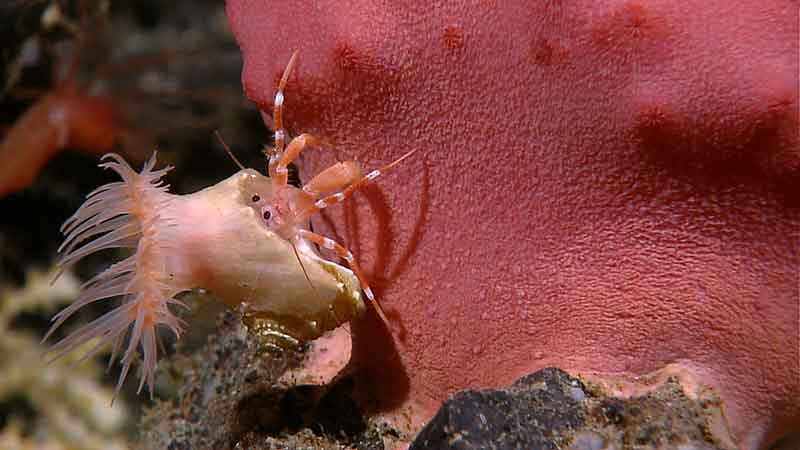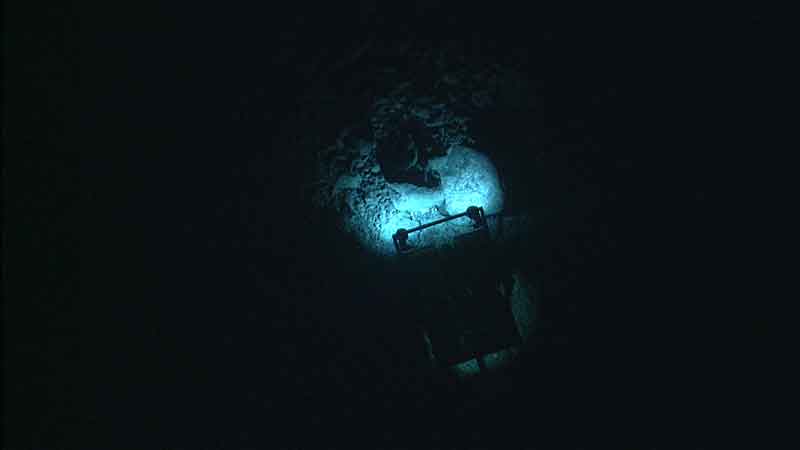
by Eleanor Bors, Doctoral Student, Woods Hole Oceanographic Institution
July 12, 2010

A sea anemone and hermit crab share a snail shell, providing a wonderful example of commensalism. The anemone (like all cnidarians) has stinging cells that help protect the crab from predators and benefits from having a free ride around the seafloor habitat, as well as receiving scraps from the crab's feeding activities. When the crab outgrows its borrowed shell, it finds a larger vacant shell...and brings the anemone along to share its new home. Image courtesy of the NOAA Office of Ocean Exploration and Research, INDEX-SATAL 2010. Download larger version (jpg, 1.5 MB).
As I sit in Seattle, Washington, in our technologically equipped "Exploration Command Center" (ECC), I can’t help but marvel at viewing live deep-sea creatures half a world away, and thousands of feet deep, in real time. A tunicate – commonly known as a sea squirt – retracts in response to the slight water disturbance caused by the remotely operated vehicle (ROV), Little Hercules; a hermit crab, adorned with anemones, marches along the seafloor; a massive population of barnacles feeds on passing plankton, using their cirri (feathery feeding structures that come out of the barnacle to snag food from the water column) to catch errant plankton.
Most people have never seen a barnacle feed in the intertidal zone, much less in the deep sea. This may be because these people don’t live near an ocean or because it doesn’t seem like a good use of their time. Perhaps others don’t stop to look because barnacles appear to be statues at first glance. Next time you have a minute or two and you’re near the water, find a tide pool or maybe some barnacles on a dock piling and watch them for a while. Be patient and I promise you’ll witness something utterly fascinating.
Now imagine yourself watching a live video feed of a deep-sea barnacle execute that very same ecological necessity – the search for food – 1,880 meters under the surface of Indonesian waters. It could be a new species, never described before. As you watch, you toss another potato chip into your mouth, and at that same moment, the barnacle snags another piece of plankton. It’s an amazing feeling! Getting to experience that feeling via real-time telepresence is one of the personal highlights of involvement in this cruise. You, too, can view the deep-sea barnacles doing their thing in the video below.
Barnacles feeding at Kawio Barat. These barnacles are stalked, which most likely benefits the barnacle by getting it up off the seafloor and into the water column, raising its likelihood of encountering passing plankton while feeding. Video courtesy of the NOAA Office of Ocean Exploration and Research, INDEX-SATAL 2010. Download larger version (mp4, 36.7 MB).
"Alright," you say, "we’ve seen the barnacle feed. So what?" What does it mean to discover these organisms on the ocean floor? This cruise is more than an educational opportunity for those involved. Ocean exploration benefits society as a whole.
When thinking about conserving marine resources in an attempt to sustainably interact with ecosystems, marine scientists struggle with the concept of baselines. What does this mean? To accurately assess the health of an ecosystem or how a marine population is faring in the face of anthropogenic disturbance (e.g., pollution, climate change, fishing, etc.), it is important to know what it was like before it experienced those disturbances. The problem is that all too often, it’s impossible to get accurate baseline data. In the deep sea, for example, we have little to no idea what much of the seafloor even looks like.

The remotely operated vehicle Little Hercules hovers over the seafloor, shedding light on previously unseen terrain. Cutting-edge technology like Little Hercules facilitates exploration and research in the deep sea. Image courtesy of the NOAA Office of Ocean Exploration and Research, INDEX-SATAL 2010. Download larger version (jpg, 1.4 MB).
I am starting this fall as a doctoral student with Dr. Timothy Shank in the Massachusetts Institute of Technology/Woods Hole Oceanographic Institution Joint Program and I am interested in understanding human impacts on deepwater habitats so that significant or sensitive areas can be effectively protected. Exploring unknown regions is the critical and irreplaceable first step towards effective management measures.
Lack of knowledge about the marine environment too frequently impedes our willingness, and sometimes our ability, to protect and use the ocean sustainably. I’m very excited by the mission of NOAA Ship Okeanos Explorer and the NOAA Office of Ocean Exploration and Research to find and understand these fascinating deep-sea ecosystems.